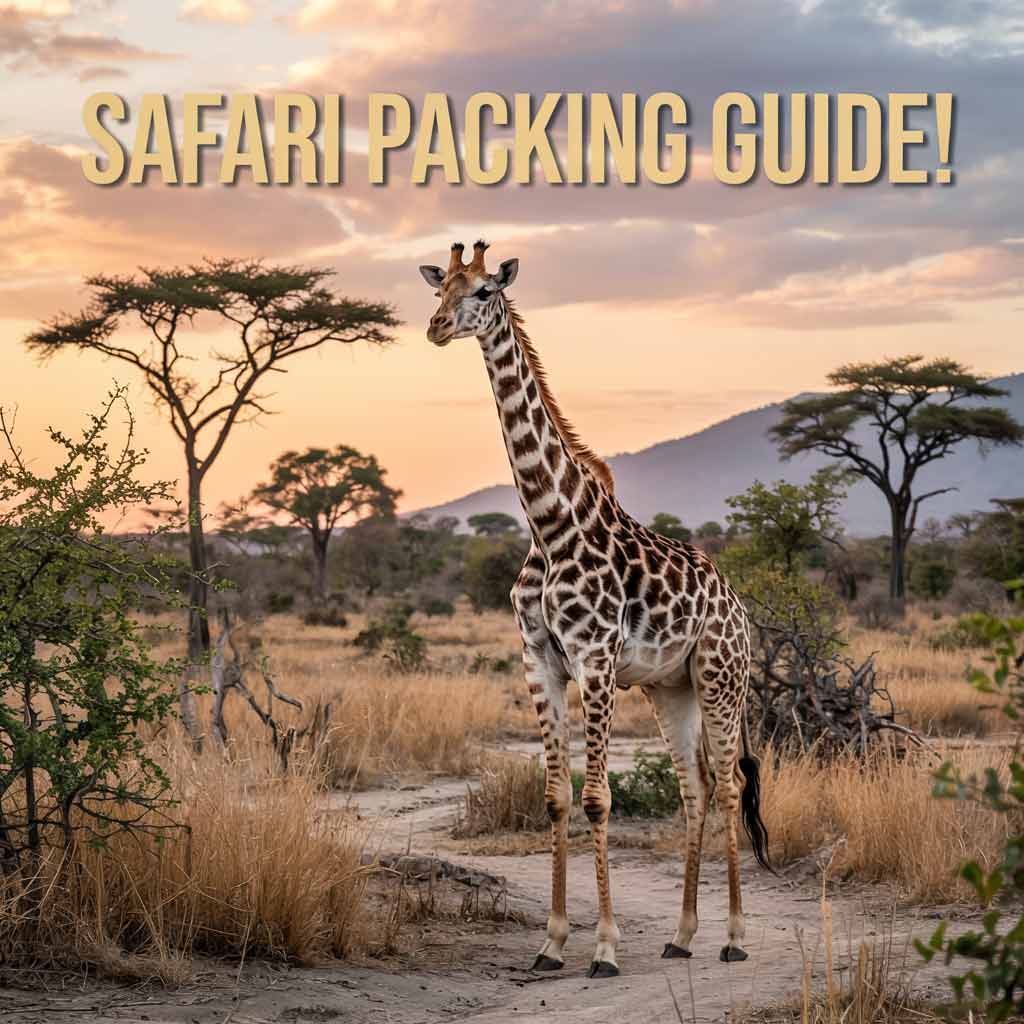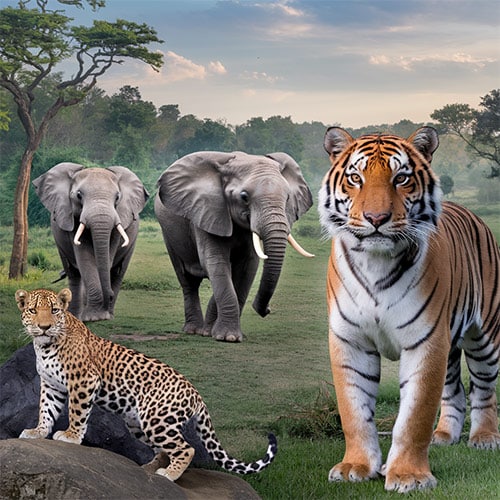Safari Packing Guide! My Tips and Must-Have Gear for Safari
If you’re planning a safari, you’re in for an adventure of a lifetime! As a solo traveler, I’ve experienced the excitement—and sometimes the chaos—of packing for a safari. One thing I’ve learned? It’s all about striking the right balance. You don’t want to overpack and be stuck lugging heavy bags, but you don’t want to forget something essential.
I’ve traveled to Africa and beyond and learned what gear truly makes a difference. In this guide, I’ll share my personal packing tips and must-have items so you can focus on enjoying your safari, not worrying about what you left behind. Let’s dive into the essentials you need for an unforgettable trip!
Safari Packing Guide: Key Essentials to Pack
Packing for a safari is all about being prepared while keeping things light. Over the years, I’ve learned that certain items are non-negotiable. These essentials have never let me down from my first safari to the more recent trips.
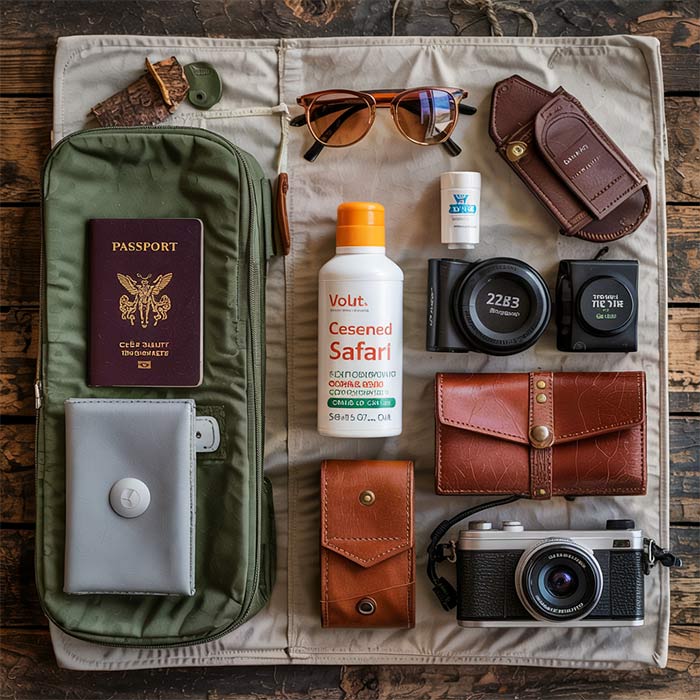
First, don’t forget your passport and travel documents—it sounds obvious, but it’s always good to double-check. As a solo traveler, I’ve habitually kept these in a safe, easily accessible spot. Travel insurance is another must-have. It’s an absolute lifesaver if anything goes wrong; trust me, you want peace of mind.
Then, there’s the money—carry a mix of cash and cards. Some places still prefer cash, and all purchases, like tips or local souvenirs. are often more straightforward. Always have a backup credit card stashed separately, just in case.
And speaking of cash, a good travel wallet is essential. I prefer something small and secure, so I don’t have to dig through a bulky bag whenever I need something. The little things like this help me stay organized and stress-free on the go.
Lastly, make sure you pack a compact travel backpack. This will be your go-to bag for daily safari excursions. I’ve learned to keep it light with water, sunscreen, camera, and snacks. You’ll want something easy to carry but durable enough to handle the adventure.
Safari Packing Guide: Luggage and Bags
When it comes to luggage for a safari, the rule of thumb is to keep it light and durable. Trust me, you don’t want to struggle with a heavy suitcase on a bumpy ride to your next adventure. Having the right luggage can make all the difference.
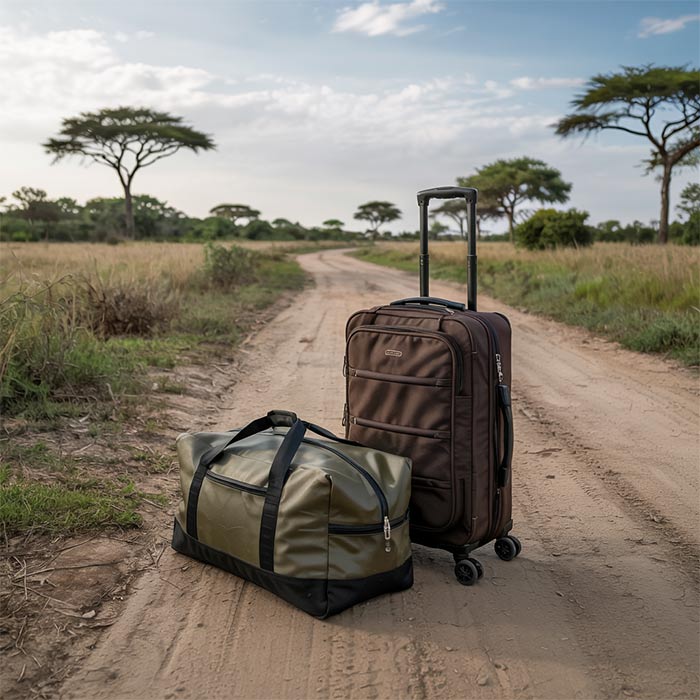
Best Types of Luggage for Safari
The best luggage for a safari is usually soft-sided. Think duffel bags or travel backpacks. These are easy to pack, squish into tight spaces, and are much better suited for the small, light aircraft often used to reach safari destinations. I love using a large duffel bag with a sturdy strap. It’s perfect for fitting everything I need without overpacking. Plus, it’s easier to handle than a hard-shell suitcase when navigating rough terrain.
Another great option is a rolling duffel bag. It’s a great compromise between a traditional suitcase and a duffel bag, offering easy transport while still being flexible enough to fit into small spaces. You’ll also want to ensure it’s water-resistant—safaris can get dusty, and you don’t want your gear to be soaked if it rains.
Packing Tips for Luggage
Here’s my packing tip: don’t overpack! I’ve been guilty of this, and it just becomes a hassle. I’ve learned to pack only the essentials, focusing on versatile items that can work for multiple situations.
First, roll your clothes to save space. Trust me, this is a game-changer. You’ll be surprised at how much more you can fit when moving instead of folding. I also use packing cubes to organize my clothes, making it easy to find exactly what I need without making a mess.
I recommend using ziplock bags for toiletries and small items—they’re simple and help keep everything dry and organized. When packing shoes, I put them in separate dust bags or plastic bags to keep everything clean and organized. And for my camera and electronics, I always carry them in a protective case. The last thing you want is to arrive with a cracked lens or broken gadget!
Lastly, don’t forget the weight limit on small planes. Most safari flights have strict weight restrictions (often around 15-20 kg), so be mindful when packing. I’ve had to leave behind a few non-essential items, and although it was frustrating, it’s always better to be safe than sorry. Keep your luggage lightweight and easily manageable—it’ll save you a lot of headaches later on.
Safari Packing Guide: Clothing
What you wear on a safari is just as important as the gear you bring. After all, you’ll spend much time outdoors, often in extreme conditions. Over the years, I’ve learned to stay comfortable, stylish, and safe during my safari adventures.
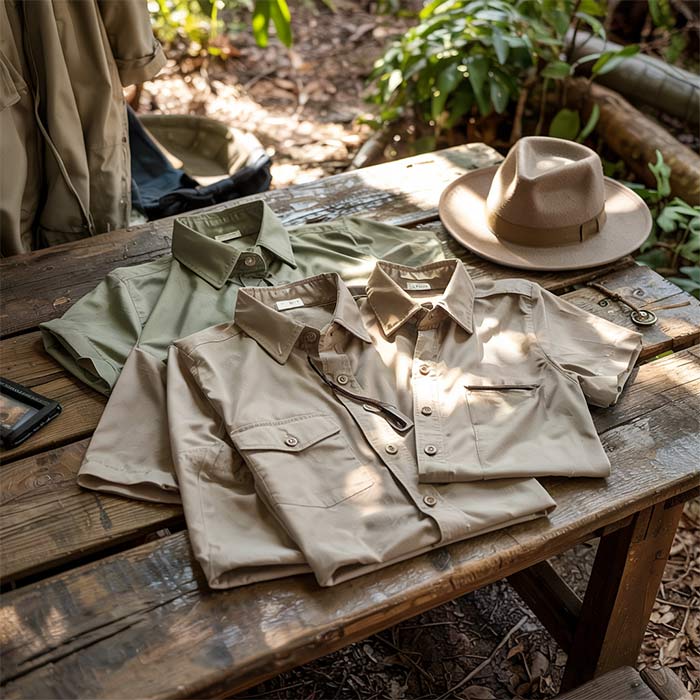
What to Wear on Safari
Comfort and functionality are key to safari clothing. I always opt for lightweight, breathable fabrics like cotton or linen. These materials keep me calm during the hot midday sun but are also durable enough to handle the wear and tear of a safari. Neutral colors like khaki, olive, brown, and tan are perfect because they help you blend in with the natural surroundings (plus, they’re practical for hiding dust or dirt).
I pack long-sleeve shirts and long pants to protect my skin from the sun and mosquitoes. Trust me, lightweight long sleeves are much cooler than they sound, and they’re a lifesaver for those early morning game drives when the temperature is still a bit chilly.
Layering for Different Weather Conditions
I’ve learned that the weather on a safari can change fast. Layering is essential for this reason. In the morning, you’ll need a light insulating jacket or a fleece because temperatures can dip quite low, especially on those early drives. As the day heats, you’ll want to shed that layer and switch to a light shirt or t-shirt.
I always pack a lightweight, packable rain jacket just in case the weather turns unexpectedly. It doesn’t take up much room, and it’s saved me from getting soaked more than once. When I layer correctly, I’m ready for anything the safari throws me—a chilly morning or a hot afternoon.
Footwear Recommendations
When it comes to footwear, comfort is the top priority. You’ll be doing a lot of walking and have shoes that can handle it. I highly recommend sturdy, supportive hiking boots. Look for a waterproof and breathable pair—trust me, your feet will thank you when you’re walking through muddy trails or crossing rivers.
I pack comfortable sandals or flip-flops for lighter activities, like relaxing at camp or going on shorter walks. They’re perfect for letting your feet breathe after a long day of trekking through the bush.
Lastly, remember to break in your boots before you go. The last thing you want is to get blisters on your first safari day! I always wear my shoes on a few test hikes before the trip to avoid uncomfortable surprises.
Safari Packing Guide: Toiletries and Personal Care
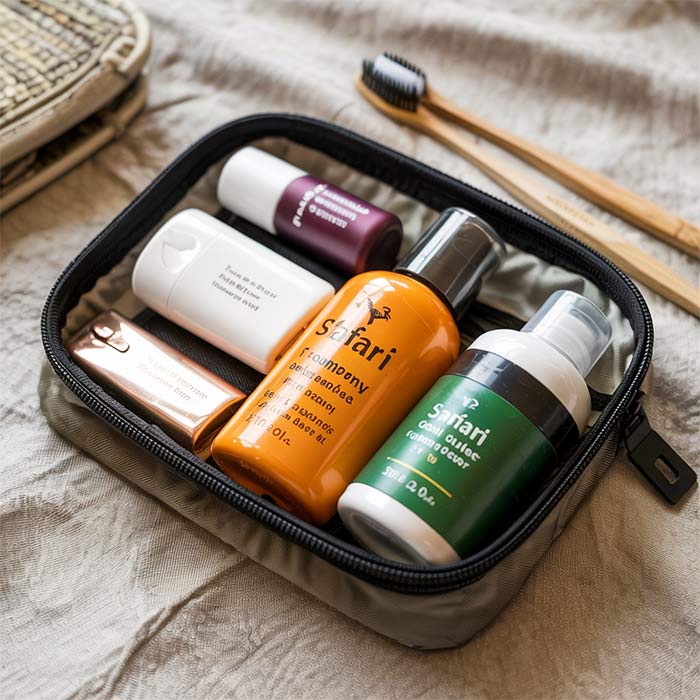
You don’t need a full-on beauty routine when you’re out in the wild, but taking care of your basic hygiene and comfort is essential. Over time, I’ve figured out what toiletries I need on safari and what I can leave behind. Here’s my guide to keeping things simple yet effective.
Must-Have Toiletries
There are a few toiletries I never leave home without. First and foremost, sunscreen is a must—especially with all the time spent outdoors. I always go for a broad-spectrum SPF 50+ to protect my skin from those harsh sun rays. Insect repellent is another essential. Safari means being in the bush, and I’ve learned that bugs are pretty persistent, especially at dusk. A good repellent with DEET works wonders.
I also bring a travel toothbrush and toothpaste—keeping my teeth fresh after those long drives and dusty days is a little luxury that makes all the difference. Don’t forget hand sanitizer. It’s not only convenient, but it’s also practical when there aren’t always clean facilities available. A lip balm with SPF is a lifesaver for dry lips after hours under the sun.
Lastly, moisturizer is key—your skin can dry out quickly in the African heat, so I always bring something hydrating to keep my skin soft. I also carry wet wipes for quick clean-ups during the day when you’re out in the bush and can’t access a shower.
What Not to Bring
While it’s tempting to pack everything that makes you feel pampered, there are some items you can leave behind. For one, heavy makeup isn’t necessary. On safari, the last thing I want to worry about is my mascara running under the hot sun. Also, fragrances are a no-go—strong smells can attract insects and wildlife. Stick to light, unscented products instead.
Hairdryers are also a waste of space—most safari camps don’t have the electricity to power them, and let’s be honest, the last thing you want to do in the bush is fuss over your hair. And while it’s tempting to bring multiple bottles of shampoo or conditioner, a small, travel-size bottle of each is more than enough for your entire trip.
Travel-Friendly Toiletries
Space is limited on a safari, so I pack smart when it comes to toiletries. I use travel-sized containers to decant my favorite products and avoid carrying bulky bottles. For instance, I’ll bring a multi-use balm that works as a lip balm, hand cream, and even a quick remedy for dry skin patches. This way, I cut down on what I need to pack but still have what I need to stay comfortable.
I also love solid shampoo bars—they last longer, take up less space, and are eco-friendly. And, of course, don’t forget a small, quick-dry towel for those mornings when you’re heading out before sunrise and need a fresh face. It’s lightweight and folds up easily, yet it’s great for quick clean-ups.
Safari Packing Guide: Camera and Photography Gear
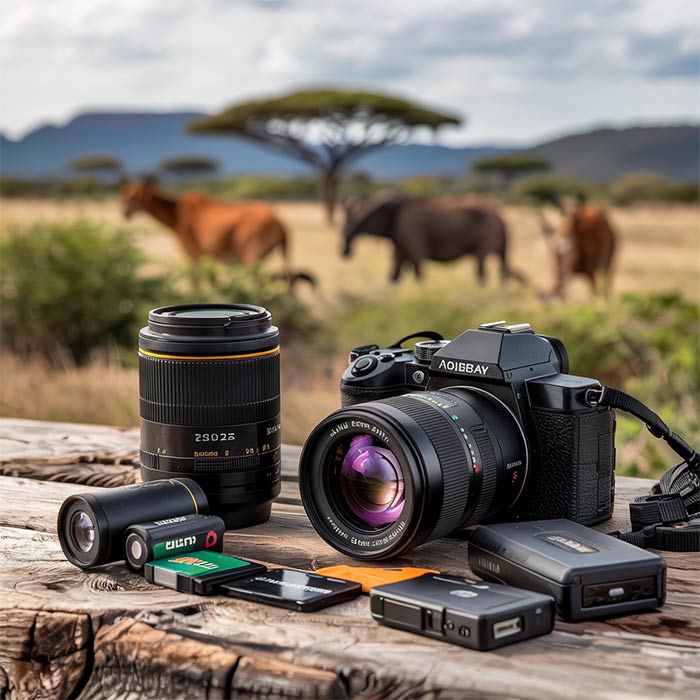
A safari is an unforgettable adventure; you’ll want to capture every moment. Trust me, as someone who’s been on countless safaris, there’s nothing like snapping that perfect shot of a lion in the wild or an elephant walking through the savannah. But packing the right camera gear is key to getting those great shots.
Must-Have Camera Equipment for Safari
The most important piece of gear you’ll need is a good camera. I swear by my DSLR camera for its quality and versatility. I use a zoom lens (at least 70-300mm) for those far-off wildlife shots. You’ll often find animals in the distance, and being able to zoom in is a game-changer. For those close-up moments, I also carry a wide-angle lens for capturing the full beauty of the landscape or a group of animals.
A high-quality memory card is a must-have. I carry extra cards because you’ll end up taking way more photos than you expect. There’s nothing worse than running out of space when the perfect shot presents itself. And don’t forget about extra batteries—safari days can be long, and you’ll need your camera ready at all times. I’ve learned that it’s always good to have a backup.
If you’re serious about photography, consider bringing a sturdy camera bag that protects your gear. I recommend something easy to carry and quick to access—you never know when a zebra might appear next to the jeep!
Other Photography Essentials
Beyond the camera are a few extra items I never leave behind. A tripod can be handy for those early morning or late evening shots when working with lower light. I’ve found a small, compact travel tripod works best for safaris. It’s light enough to carry around but sturdy enough to stabilize your camera.
If you plan on filming your safari, a smartphone gimbal is a great tool for steady footage, especially on bumpy roads or game drives. It helps keep your video smooth and professional without the shaky footage that can happen with handheld shots.
Lens cleaning supplies are crucial. Safari can be dusty, and I always pack a lens cloth and a lens brush to keep my gear clean. I also carry a rain cover for my camera in case of unexpected weather—it can rain any moment, and I’ve learned the importance of protecting my gear.
Lastly, a pair of binoculars is invaluable if you’re serious about capturing the safari experience. I always bring a compact pair—they’re lightweight, don’t take up much space, and are perfect for getting a closer look at wildlife without disturbing them.
Safari Packing Guide: Health and Safety Essentials
Your health and safety should always be a priority, especially when you’re far from the comforts of home. Over my travels, I’ve learned a few crucial tips to stay safe and healthy on a safari. Here’s what you need to pack and consider for a worry-free experience.
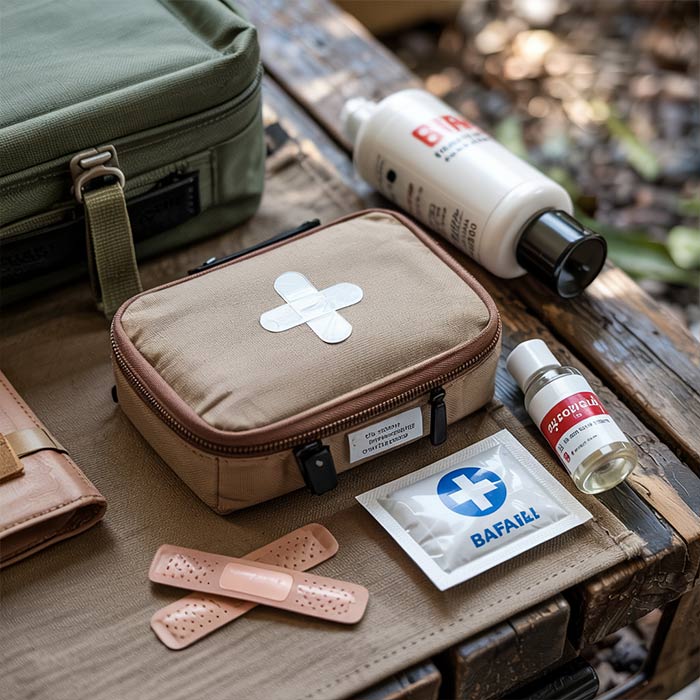
First-Aid Kit
A good first-aid kit is a must. I always bring the basics like band-aids, gauze, and antiseptic wipes. It’s also wise to include pain relievers like ibuprofen in case you have a headache or body aches after a long day in the bush. One item I never skip is anti-diarrheal medicine—trust me, it can be a lifesaver if your stomach doesn’t quite agree with the local food.
I also pack allergy medication (just in case) and motion sickness tablets for those bumpy rides between game drives. And don’t forget about mosquito bite relief—I always bring something to soothe the itching, like a topical cream or stick.
It’s easy to overlook a first-aid kit, but it can make all the difference when dealing with minor injuries or discomfort. And remember to include any personal prescriptions you might need, like an inhaler or allergy medication. A small, portable kit means you’re prepared for anything, big or small.
Health Considerations
Before you leave, I highly recommend checking in with your doctor about necessary vaccinations or medications. You may need shots for diseases like yellow fever or malaria, depending on where you’re going. In my experience, getting these sorted before the trip takes a huge weight off your shoulders.
I also pack malaria tablets if traveling to an area where the disease is a concern. Even though taking precautions is important, I also wear long sleeves and pants at dawn and dusk, when mosquitoes are most active. In some places, insect nets are provided at your lodging, which is an added bonus.
Staying hydrated is another health consideration. Safari days are long and active, and the heat can be intense. I always carry a reusable water bottle and drink plenty of water throughout the day. There’s nothing worse than feeling sluggish or dizzy from dehydration in the middle of a safari.
Water and Food Safety
Speaking of hydration, water safety is a key concern while on safari. Most lodges and camps will provide bottled or purified water, but it’s always a good idea to double-check. I recommend carrying a water purifier or water purification tablets—just in case you end up somewhere, the water might not be safe to drink.
I stick to meals prepared at my lodge or camp for food safety. Street food might seem tempting, but I’ve learned it’s best to play it safe and avoid anything that could upset my stomach. When I’m out on a game drive or during other excursions, I always pack snacks like granola bars or fruit that don’t require refrigeration. A handy snack keeps my energy up and helps me avoid unnecessary hunger pangs.
Safari Packing Guide: Miscellaneous Gear
While clothing and toiletries are essential, a few miscellaneous items can make your safari experience smoother, more comfortable, and even more enjoyable. After many safaris, I’ve learned that having the right extra gear can make a big difference. Here’s what I always pack.
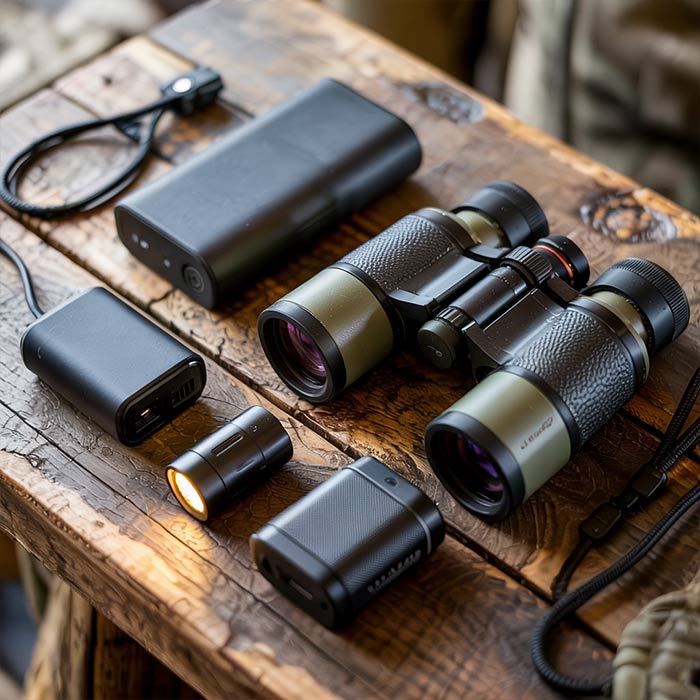
Must-Have Gadgets
Nowadays, a few gadgets can be helpful while on safari. First, a power bank is a must-have. Your phone or camera battery will drain quickly since you’ll be out in the bush all day. I never leave home without a portable charger to keep my devices going when there’s no access to power.
A travel adapter is also essential. If you’re traveling internationally, the last thing you want is to be stuck without a way to charge your electronics. I always pack a universal travel adapter that works in most places. It’s small, lightweight, and keeps my gadgets charged and ready to go.
If you’re into photography, a headlamp or small flashlight can be helpful for early morning or late-night game drives or when returning to camp after dark. A multi-tool or Swiss army knife is handy when you need something sharp, like cutting open a snack or fixing a piece of equipment.
Books, Journals, and Entertainment
On safari, you’ll likely spend a lot of time relaxing between activities. After a long day of game drives, I always pack a good book or two to unwind in the evenings. Whether it’s a safari memoir, a gripping novel, or a wildlife guide, books help me enjoy those quiet moments at the camp.
A journal is another item I never skip. Writing about the day’s experiences is one of my favorite things to do while traveling. I jot down thoughts, moments, and memories—especially when I spot something amazing like a pride of lions or a giraffe strolling across the savannah. It’s a great way to preserve your adventure and reflect on your journey.
I also bring a deck of cards or a travel-sized game for some downtime. These small items are perfect for socializing with fellow travelers or just passing the time at the camp. It’s a nice way to relax after a busy day.
Extra Items You Might Consider
I pack a few more items depending on the type of safari I’m going on. A lightweight rain poncho is something I’ve learned to carry—sudden rain showers are not uncommon, and it’s easy to throw on for a quick game drive or walk.
If you’re a fan of stargazing, which I absolutely am, a small pair of binoculars can enhance your night sky experience. The African skies are stunning, and spotting constellations or the Milky Way from your camp is a magical experience.
Finally, I always bring a small dry bag for electronics or valuables, especially on boat safaris or near water. It’s great for protecting your camera, phone, or any other items from water or dust.
Packing these extra items may seem like little things, but they add to the safari experience. With the right gadgets, entertainment, and thoughtful extras, you’ll be well-prepared for whatever your safari throws your way!
Safari Packing Guide: Final Tips
Now that we’ve covered all the essentials, let’s wrap up with some final packing tips to make your safari experience even more enjoyable. After years of packing for safaris, I’ve picked up some tricks to help me stay organized, comfortable, and stress-free. Here’s what I always keep in mind.
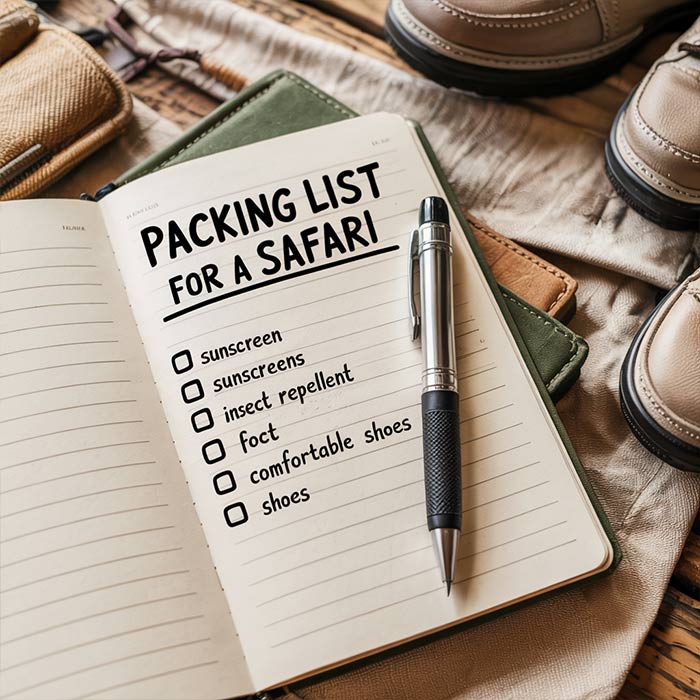
Packing for Convenience
When it comes to packing, convenience is key. You’ll be on the move a lot, so you want everything easy to access and lightweight. I pack my day bag (the one I’ll carry on game drives) with only the essentials: a camera, sunscreen, water, snacks, and a light jacket. That way, I’m not digging through a giant suitcase when heading out for an early morning drive or a quick outing.
Ziploc bags are my best friend for organizing small items like toiletries, cables, and snacks. They keep everything neat and dry and are easy to pull out of your bag without making a mess. I also love packing cubes for clothes—they compress everything and keep my bag organized.
When it comes to toiletries, I make sure everything is travel-sized to avoid taking up too much space. And I keep my electronics in a small, waterproof case—no more rummaging around for my charger in the rain!
Don’t Overpack!
One of the biggest mistakes I see people make is overpacking. Bringing everything “just in case “is tempting, but safari travel is all about being efficient and light. The more you pack, the heavier your bag, and the more difficult it becomes to navigate bumpy rides or small planes. I’ve learned that less is more.
Stick to the basics, and make sure each item serves a purpose. Don’t bring things you won’t use, like extra shoes or an excessive number of outfits. Safari is about experiencing wildlife and nature, not looking fashionable in every outfit. I always remind myself to focus on versatility—each piece of clothing should be something I can wear more than once and easily mix and match.
Preparing for Different Safari Types
Different types of safaris require different packing strategies. For instance, if you’re heading on a luxury safari with comfortable lodges and private vehicles, you can pack more—think dresses for dinners, extra camera gear, and maybe a pair of stylish shoes for the evenings.
However, you’re going on a camping or mobile safari with limited space and more basic accommodations. You’ll want to stick to the essentials and opt for more practical, rugged gear. I’ve learned that lightweight, moisture-wicking clothes are a must when staying in camps, and comfort is far more important than style.
For those going on a gorilla trekking safari or a walking safari, pack sturdy, comfortable hiking boots and a lightweight backpack for essentials. This will prepare you for the physical demands of trekking through the wilderness, especially hiking in mountainous terrain or dense forests.
No matter the type of safari, the key is to pack for what suits your trip and your comfort level. Focus on practicality, but don’t forget to bring a few items that make your journey more enjoyable!
Conclusion
Packing for a safari doesn’t have to be stressful. Focus on versatile, comfortable, and practical items that suit your adventure. From essential camera gear to clothing and health essentials, every item plays a part in ensuring you’re prepared for whatever comes your way.
Remember, less is more—don’t overpack. With these tips, you’ll be ready to enjoy your safari and make unforgettable memories. Safe travels, and happy adventuring!

